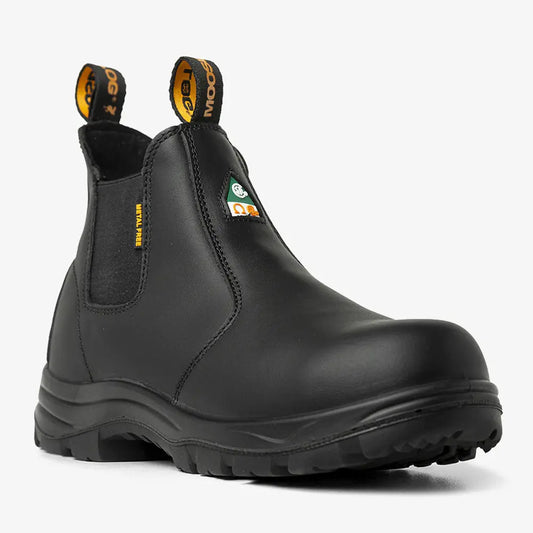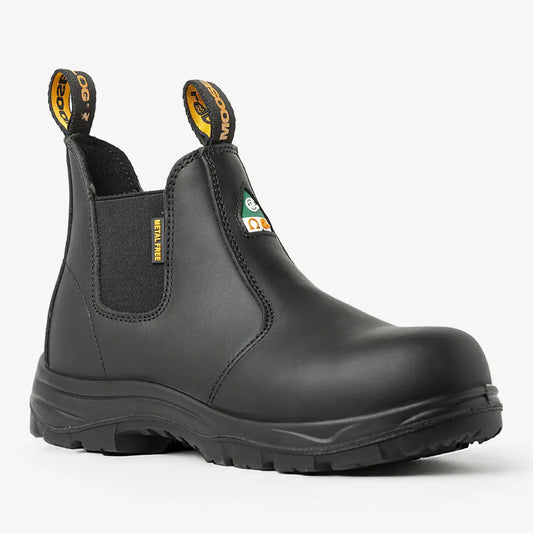
7 Essential Features Every CSA Approved Work Boot Should Have
Work boots are personal protective equipment that directly impacts your safety, compliance, and long-term health. In Canada, workers across construction, warehousing, utilities, and transportation rely on CSA approved work boots to meet strict national safety standards. Choosing the right pair means looking past style and price tags. It means evaluating the features that keep you safe, comfortable, and compliant every single day.
This guide breaks down the seven essential features every CSA certified boot should include. Whether you work on concrete floors, muddy lots, or electrical environments, these are the benchmarks you need to check before buying.
1. Toe Protection (Composite, Steel, or Alloy)
Toe protection is the most visible feature of a certified safety boot. CSA Grade 1 requires boots to withstand 125 joules of impact and 1,500 Newtons of compression. CSA Group provides the full breakdown of these requirements.
Steel toe has been the traditional option, but composite toe boots are now the preferred choice for many Canadian workers. Composite materials are lighter, non-metallic, and do not conduct temperature, making them more comfortable in extreme weather. Alloy toe caps offer a thinner profile but provide similar protection.
When inspecting safety boots, look for the green triangle patch that confirms Grade 1 protection. Without this label, you cannot be certain the boot will pass inspection or meet employer requirements.
Related Article: Steel Toe, Composite Toe, or Alloy Toe? Choosing the Right Safety Boot for Your Needs
2. Puncture-Resistant Plate

Jobsites are full of hazards underfoot: nails, glass, metal shards, and sharp rebar. CSA standards require a puncture-resistant plate in Grade 1 boots. This midsole barrier prevents sharp objects from penetrating through the outsole into your foot. Composite plates offer flexibility and keep the overall weight low compared to steel plates.
A puncture-resistant boot is not optional if you work around construction debris, scrap yards, or manufacturing plants. Employers enforce this requirement because workplace injuries from foot punctures are both common and costly.
MooseLog Timber Work Boots include a CSA-approved puncture-resistant plate built to last in heavy-duty environments.
3. Slip-Resistant Outsoles

Slips and falls remain one of the leading causes of workplace injuries in Canada. A proper slip resistant work boot is designed with tread patterns and rubber compounds that grip surfaces like oil, water, and snow. CSA testing ensures soles meet minimum friction requirements.
Look for boots with rubber outsoles like Vibram® or SafeTread™, both engineered for superior traction. They perform on concrete, asphalt, and metal surfaces while resisting abrasion. A slip-resistant outsole also extends the life of your boots, as cheaper rubber compounds wear down quickly and lose traction.
4. Electrical Hazard or ESR Protection

Construction and trade environments often involve electrical risks. Electrical Shock Resistant (ESR) boots are marked with the white rectangle and orange omega symbol. They are tested to withstand 18,000 volts at 60 Hz for one minute with no leakage. For anyone working with live circuits, power tools, or utility lines, ESR certification is non-negotiable.
When reviewing work boots, confirm both the CSA symbol and the ASTM F2413 “EH” marking. This dual certification proves compliance in both Canada and the United States, ensuring your boots meet inspection standards no matter where the job takes you.
5. Comfort and Support
Safety features mean little if the boots are painful to wear. Long shifts demand insoles that cushion every step and reduce strain on joints. High rebound polyurethane (PU) or layered memory foam insoles provide shock absorption and energy return.
Support is also determined by the midsole and arch design. A well-structured boot reduces fatigue, prevents foot collapse, and helps maintain posture across 10–12 hour shifts. Comfort is not luxury—it is performance. A worker distracted by foot pain is less focused on safety and productivity.
Check out our guide: Why Are Work Boots So Uncomfortable? for deeper insights into fit and comfort.
6. Durable Construction and Quality Materials

The lifespan of your work boots depends on the construction method and material quality. Full-grain leather remains the standard for durability, offering resistance to abrasion and weather. Direct-attach polyurethane outsoles bond the upper and sole into a single structure that resists splitting. Advanced stitching and reinforced seams ensure boots hold up under constant stress.
A durable work boot is a cost-effective investment. Frequent replacements drain both wallets and productivity. Choosing boots that last longer reduces downtime and lowers long-term expenses for both workers and employers.
7. Proper Certification and Labelling

CSA certification is a requirement for Canadian worksites. Every approved boot must carry the correct patch:
- Green Triangle = Grade 1 toe and puncture resistance
- White Rectangle with Orange Omega = Electrical Shock Resistant
ASTM F2413 is the U.S. standard for protective footwear. Having ASTM compliance is good if you work across the border, handle contracts with American companies, or need proof that your boots meet North American standards. ASTM covers impact resistance, compression strength, puncture protection, and electrical hazard defence, making it the benchmark for U.S. worksites.
Employers and inspectors in both Canada and the U.S. rely on these markings to confirm safety. Always verify CSA patches and ASTM labels before purchase to avoid non-compliance on the job.
Conclusion
Every CSA approved work boot should combine protection, comfort, and durability. Toe caps, puncture plates, slip resistance, electrical protection, ergonomic insoles, quality construction, and verified certification are the non-negotiable features. Cutting corners in any one of these areas compromises your safety and puts your compliance at risk.
When you buy boots that meet these seven standards, you invest in confidence on the jobsite. That confidence translates into fewer injuries, stronger performance, and better value over time.
Ready to upgrade? Explore MooseLog’s CSA and ASTM Certified Work Boots built for Canadian and U.S. jobsite requirements.
Frequently Asked Questions
What does CSA Grade 1 mean on work boots?
Grade 1 indicates the highest level of toe protection under CSA Z195. It withstands 125 joules of impact and 1,500 Newtons of compression.
How do I know if my boots are CSA approved?
Look for the CSA triangle patch stitched or stamped on the boot, along with additional symbols like the Omega mark for electrical resistance.
What’s the difference between CSA and ASTM boots?
CSA boots meet Canadian safety standards (Z195), while ASTM boots meet U.S. standards (F2413). Dual-certified boots pass both, making them suitable for North America.
Are composite toe boots as safe as steel toe boots?
Yes. Composite toe boots meet the same impact and compression standards as steel toe boots. They are lighter and metal-free, which adds comfort.
How long should a pair of CSA work boots last?
Most quality boots last 12–18 months with daily use. Longevity depends on materials, construction, and work conditions. Inspect regularly for wear and replace when the outsole, toe, or plate shows damage.
Do all jobs require CSA boots?
Most industrial, construction, and utility employers require CSA certified boots. Always check your workplace safety policy before starting a new job.






